Feifei Zhao
Redefining Superalignment: From Weak-to-Strong Alignment to Human-AI Co-Alignment to Sustainable Symbiotic Society
Apr 24, 2025Abstract:Artificial Intelligence (AI) systems are becoming increasingly powerful and autonomous, and may progress to surpass human intelligence levels, namely Artificial Superintelligence (ASI). During the progression from AI to ASI, it may exceed human control, violate human values, and even lead to irreversible catastrophic consequences in extreme cases. This gives rise to a pressing issue that needs to be addressed: superalignment, ensuring that AI systems much smarter than humans, remain aligned with human (compatible) intentions and values. Existing scalable oversight and weak-to-strong generalization methods may prove substantially infeasible and inadequate when facing ASI. We must explore safer and more pluralistic frameworks and approaches for superalignment. In this paper, we redefine superalignment as the human-AI co-alignment towards a sustainable symbiotic society, and highlight a framework that integrates external oversight and intrinsic proactive alignment. External oversight superalignment should be grounded in human-centered ultimate decision, supplemented by interpretable automated evaluation and correction, to achieve continuous alignment with humanity's evolving values. Intrinsic proactive superalignment is rooted in a profound understanding of the self, others, and society, integrating self-awareness, self-reflection, and empathy to spontaneously infer human intentions, distinguishing good from evil and proactively considering human well-being, ultimately attaining human-AI co-alignment through iterative interaction. The integration of externally-driven oversight with intrinsically-driven proactive alignment empowers sustainable symbiotic societies through human-AI co-alignment, paving the way for achieving safe and beneficial AGI and ASI for good, for human, and for a symbiotic ecology.
Continual Learning of Multiple Cognitive Functions with Brain-inspired Temporal Development Mechanism
Apr 08, 2025Abstract:Cognitive functions in current artificial intelligence networks are tied to the exponential increase in network scale, whereas the human brain can continuously learn hundreds of cognitive functions with remarkably low energy consumption. This advantage is in part due to the brain cross-regional temporal development mechanisms, where the progressive formation, reorganization, and pruning of connections from basic to advanced regions, facilitate knowledge transfer and prevent network redundancy. Inspired by these, we propose the Continual Learning of Multiple Cognitive Functions with Brain-inspired Temporal Development Mechanism(TD-MCL), enabling cognitive enhancement from simple to complex in Perception-Motor-Interaction(PMI) multiple cognitive task scenarios. The TD-MCL model proposes the sequential evolution of long-range connections between different cognitive modules to promote positive knowledge transfer, while using feedback-guided local connection inhibition and pruning to effectively eliminate redundancies in previous tasks, reducing energy consumption while preserving acquired knowledge. Experiments show that the proposed method can achieve continual learning capabilities while reducing network scale, without introducing regularization, replay, or freezing strategies, and achieving superior accuracy on new tasks compared to direct learning. The proposed method shows that the brain's developmental mechanisms offer a valuable reference for exploring biologically plausible, low-energy enhancements of general cognitive abilities.
Autonomous Alignment with Human Value on Altruism through Considerate Self-imagination and Theory of Mind
Jan 07, 2025Abstract:With the widespread application of Artificial Intelligence (AI) in human society, enabling AI to autonomously align with human values has become a pressing issue to ensure its sustainable development and benefit to humanity. One of the most important aspects of aligning with human values is the necessity for agents to autonomously make altruistic, safe, and ethical decisions, considering and caring for human well-being. Current AI extremely pursues absolute superiority in certain tasks, remaining indifferent to the surrounding environment and other agents, which has led to numerous safety risks. Altruistic behavior in human society originates from humans' capacity for empathizing others, known as Theory of Mind (ToM), combined with predictive imaginative interactions before taking action to produce thoughtful and altruistic behaviors. Inspired by this, we are committed to endow agents with considerate self-imagination and ToM capabilities, driving them through implicit intrinsic motivations to autonomously align with human altruistic values. By integrating ToM within the imaginative space, agents keep an eye on the well-being of other agents in real time, proactively anticipate potential risks to themselves and others, and make thoughtful altruistic decisions that balance negative effects on the environment. The ancient Chinese story of Sima Guang Smashes the Vat illustrates the moral behavior of the young Sima Guang smashed a vat to save a child who had accidentally fallen into it, which is an excellent reference scenario for this paper. We design an experimental scenario similar to Sima Guang Smashes the Vat and its variants with different complexities, which reflects the trade-offs and comprehensive considerations between self-goals, altruistic rescue, and avoiding negative side effects.
Evolving Efficient Genetic Encoding for Deep Spiking Neural Networks
Nov 11, 2024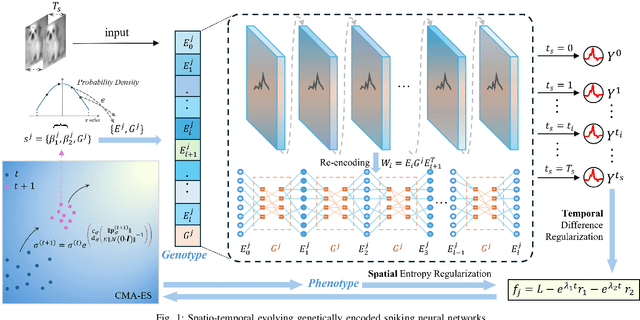
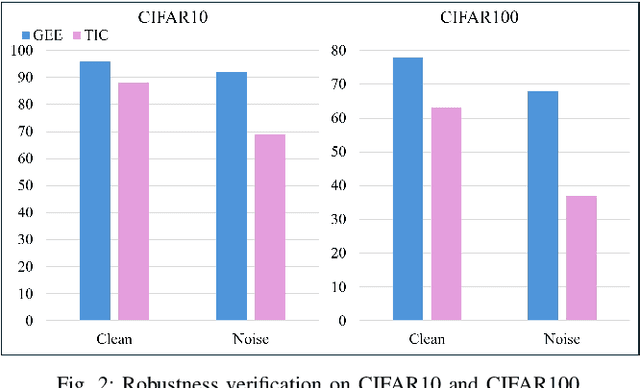
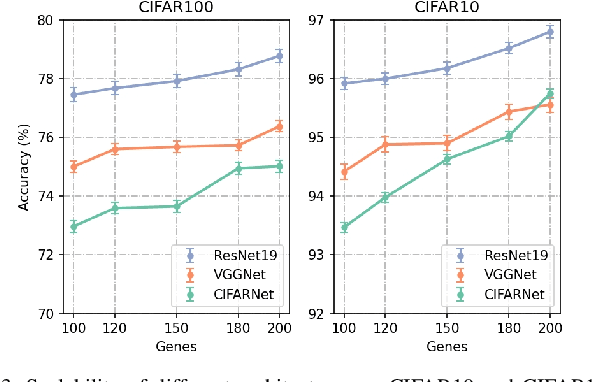
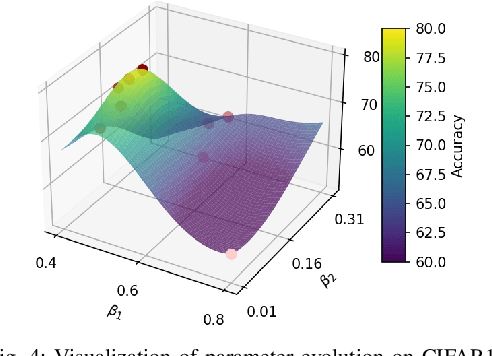
Abstract:By exploiting discrete signal processing and simulating brain neuron communication, Spiking Neural Networks (SNNs) offer a low-energy alternative to Artificial Neural Networks (ANNs). However, existing SNN models, still face high computational costs due to the numerous time steps as well as network depth and scale. The tens of billions of neurons and trillions of synapses in the human brain are developed from only 20,000 genes, which inspires us to design an efficient genetic encoding strategy that dynamic evolves to regulate large-scale deep SNNs at low cost. Therefore, we first propose a genetically scaled SNN encoding scheme that incorporates globally shared genetic interactions to indirectly optimize neuronal encoding instead of weight, which obviously brings about reductions in parameters and energy consumption. Then, a spatio-temporal evolutionary framework is designed to optimize the inherently initial wiring rules. Two dynamic regularization operators in the fitness function evolve the neuronal encoding to a suitable distribution and enhance information quality of the genetic interaction respectively, substantially accelerating evolutionary speed and improving efficiency. Experiments show that our approach compresses parameters by approximately 50\% to 80\%, while outperforming models on the same architectures by 0.21\% to 4.38\% on CIFAR-10, CIFAR-100 and ImageNet. In summary, the consistent trends of the proposed genetically encoded spatio-temporal evolution across different datasets and architectures highlight its significant enhancements in terms of efficiency, broad scalability and robustness, demonstrating the advantages of the brain-inspired evolutionary genetic coding for SNN optimization.
Building Altruistic and Moral AI Agent with Brain-inspired Affective Empathy Mechanisms
Oct 29, 2024



Abstract:As AI closely interacts with human society, it is crucial to ensure that its decision-making is safe, altruistic, and aligned with human ethical and moral values. However, existing research on embedding ethical and moral considerations into AI remains insufficient, and previous external constraints based on principles and rules are inadequate to provide AI with long-term stability and generalization capabilities. In contrast, the intrinsic altruistic motivation based on empathy is more willing, spontaneous, and robust. Therefore, this paper is dedicated to autonomously driving intelligent agents to acquire morally behaviors through human-like affective empathy mechanisms. We draw inspiration from the neural mechanism of human brain's moral intuitive decision-making, and simulate the mirror neuron system to construct a brain-inspired affective empathy-driven altruistic decision-making model. Here, empathy directly impacts dopamine release to form intrinsic altruistic motivation. Based on the principle of moral utilitarianism, we design the moral reward function that integrates intrinsic empathy and extrinsic self-task goals. A comprehensive experimental scenario incorporating empathetic processes, personal objectives, and altruistic goals is developed. The proposed model enables the agent to make consistent moral decisions (prioritizing altruism) by balancing self-interest with the well-being of others. We further introduce inhibitory neurons to regulate different levels of empathy and verify the positive correlation between empathy levels and altruistic preferences, yielding conclusions consistent with findings from psychological behavioral experiments. This work provides a feasible solution for the development of ethical AI by leveraging the intrinsic human-like empathy mechanisms, and contributes to the harmonious coexistence between humans and AI.
Directly Training Temporal Spiking Neural Network with Sparse Surrogate Gradient
Jun 28, 2024



Abstract:Brain-inspired Spiking Neural Networks (SNNs) have attracted much attention due to their event-based computing and energy-efficient features. However, the spiking all-or-none nature has prevented direct training of SNNs for various applications. The surrogate gradient (SG) algorithm has recently enabled spiking neural networks to shine in neuromorphic hardware. However, introducing surrogate gradients has caused SNNs to lose their original sparsity, thus leading to the potential performance loss. In this paper, we first analyze the current problem of direct training using SGs and then propose Masked Surrogate Gradients (MSGs) to balance the effectiveness of training and the sparseness of the gradient, thereby improving the generalization ability of SNNs. Moreover, we introduce a temporally weighted output (TWO) method to decode the network output, reinforcing the importance of correct timesteps. Extensive experiments on diverse network structures and datasets show that training with MSG and TWO surpasses the SOTA technique.
Brain-inspired and Self-based Artificial Intelligence
Feb 29, 2024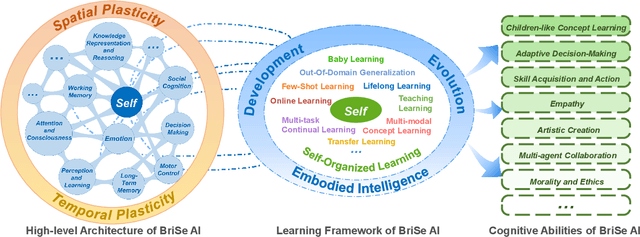
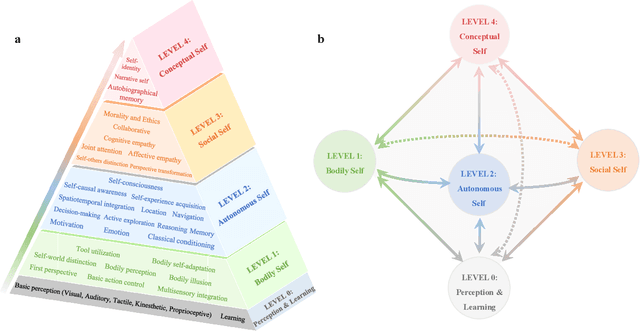
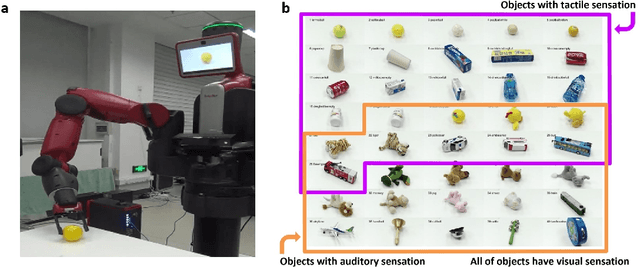
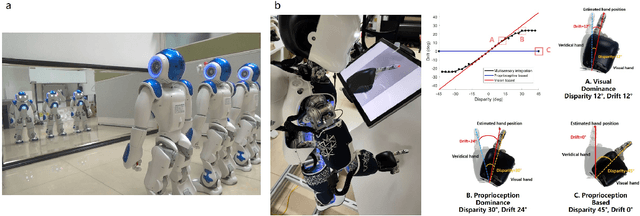
Abstract:The question "Can machines think?" and the Turing Test to assess whether machines could achieve human-level intelligence is one of the roots of AI. With the philosophical argument "I think, therefore I am", this paper challenge the idea of a "thinking machine" supported by current AIs since there is no sense of self in them. Current artificial intelligence is only seemingly intelligent information processing and does not truly understand or be subjectively aware of oneself and perceive the world with the self as human intelligence does. In this paper, we introduce a Brain-inspired and Self-based Artificial Intelligence (BriSe AI) paradigm. This BriSe AI paradigm is dedicated to coordinating various cognitive functions and learning strategies in a self-organized manner to build human-level AI models and robotic applications. Specifically, BriSe AI emphasizes the crucial role of the Self in shaping the future AI, rooted with a practical hierarchical Self framework, including Perception and Learning, Bodily Self, Autonomous Self, Social Self, and Conceptual Self. The hierarchical framework of the Self highlights self-based environment perception, self-bodily modeling, autonomous interaction with the environment, social interaction and collaboration with others, and even more abstract understanding of the Self. Furthermore, the positive mutual promotion and support among multiple levels of Self, as well as between Self and learning, enhance the BriSe AI's conscious understanding of information and flexible adaptation to complex environments, serving as a driving force propelling BriSe AI towards real Artificial General Intelligence.
YAYI 2: Multilingual Open-Source Large Language Models
Dec 22, 2023Abstract:As the latest advancements in natural language processing, large language models (LLMs) have achieved human-level language understanding and generation abilities in many real-world tasks, and even have been regarded as a potential path to the artificial general intelligence. To better facilitate research on LLMs, many open-source LLMs, such as Llama 2 and Falcon, have recently been proposed and gained comparable performances to proprietary models. However, these models are primarily designed for English scenarios and exhibit poor performances in Chinese contexts. In this technical report, we propose YAYI 2, including both base and chat models, with 30 billion parameters. YAYI 2 is pre-trained from scratch on a multilingual corpus which contains 2.65 trillion tokens filtered by our pre-training data processing pipeline. The base model is aligned with human values through supervised fine-tuning with millions of instructions and reinforcement learning from human feedback. Extensive experiments on multiple benchmarks, such as MMLU and CMMLU, consistently demonstrate that the proposed YAYI 2 outperforms other similar sized open-source models.
Adaptive Reorganization of Neural Pathways for Continual Learning with Hybrid Spiking Neural Networks
Sep 18, 2023Abstract:The human brain can self-organize rich and diverse sparse neural pathways to incrementally master hundreds of cognitive tasks. However, most existing continual learning algorithms for deep artificial and spiking neural networks are unable to adequately auto-regulate the limited resources in the network, which leads to performance drop along with energy consumption rise as the increase of tasks. In this paper, we propose a brain-inspired continual learning algorithm with adaptive reorganization of neural pathways, which employs Self-Organizing Regulation networks to reorganize the single and limited Spiking Neural Network (SOR-SNN) into rich sparse neural pathways to efficiently cope with incremental tasks. The proposed model demonstrates consistent superiority in performance, energy consumption, and memory capacity on diverse continual learning tasks ranging from child-like simple to complex tasks, as well as on generalized CIFAR100 and ImageNet datasets. In particular, the SOR-SNN model excels at learning more complex tasks as well as more tasks, and is able to integrate the past learned knowledge with the information from the current task, showing the backward transfer ability to facilitate the old tasks. Meanwhile, the proposed model exhibits self-repairing ability to irreversible damage and for pruned networks, could automatically allocate new pathway from the retained network to recover memory for forgotten knowledge.
Brain-inspired Evolutionary Architectures for Spiking Neural Networks
Sep 11, 2023



Abstract:The complex and unique neural network topology of the human brain formed through natural evolution enables it to perform multiple cognitive functions simultaneously. Automated evolutionary mechanisms of biological network structure inspire us to explore efficient architectural optimization for Spiking Neural Networks (SNNs). Instead of manually designed fixed architectures or hierarchical Network Architecture Search (NAS), this paper evolves SNNs architecture by incorporating brain-inspired local modular structure and global cross-module connectivity. Locally, the brain region-inspired module consists of multiple neural motifs with excitatory and inhibitory connections; Globally, we evolve free connections among modules, including long-term cross-module feedforward and feedback connections. We further introduce an efficient multi-objective evolutionary algorithm based on a few-shot performance predictor, endowing SNNs with high performance, efficiency and low energy consumption. Extensive experiments on static datasets (CIFAR10, CIFAR100) and neuromorphic datasets (CIFAR10-DVS, DVS128-Gesture) demonstrate that our proposed model boosts energy efficiency, archiving consistent and remarkable performance. This work explores brain-inspired neural architectures suitable for SNNs and also provides preliminary insights into the evolutionary mechanisms of biological neural networks in the human brain.
 Add to Chrome
Add to Chrome Add to Firefox
Add to Firefox Add to Edge
Add to Edge